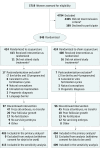Effect of Acupuncture vs Sham Acupuncture on Live Births Among Women Undergoing In Vitro Fertilization: A Randomized Clinical Trial
- PMID: 29800212
- PMCID: PMC6583254
- DOI: 10.1001/jama.2018.5336
Effect of Acupuncture vs Sham Acupuncture on Live Births Among Women Undergoing In Vitro Fertilization: A Randomized Clinical Trial
Abstract
Importance: Acupuncture is widely used by women undergoing in vitro fertilization (IVF), although the evidence for efficacy is conflicting.
Objective: To determine the efficacy of acupuncture compared with a sham acupuncture control performed during IVF on live births.
Design, setting, and participants: A single-blind, parallel-group randomized clinical trial including 848 women undergoing a fresh IVF cycle was conducted at 16 IVF centers in Australia and New Zealand between June 29, 2011, and October 23, 2015, with 10 months of pregnancy follow-up until August 2016.
Interventions: Women received either acupuncture (n = 424) or a sham acupuncture control (n = 424). The first treatment was administered between days 6 to 8 of follicle stimulation, and 2 treatments were administered prior to and following embryo transfer. The sham control used a noninvasive needle placed away from the true acupuncture points.
Main outcomes and measures: The primary outcome was live birth, defined as the delivery of 1 or more living infants at greater than 20 weeks' gestation or birth weight of at least 400 g.
Results: Among 848 randomized women, 24 withdrew consent, 824 were included in the study (mean [SD] age, 35.4 [4.3] years); 371 [45.0%] had undergone more than 2 previous IVF cycles), 607 proceeded to an embryo transfer, and 809 (98.2%) had data available on live birth outcomes. Live births occurred among 74 of 405 women (18.3%) receiving acupuncture compared with 72 of 404 women (17.8%) receiving sham control (risk difference, 0.5% [95% CI, -4.9% to 5.8%]; relative risk, 1.02 [95% CI, 0.76 to 1.38]).
Conclusions and relevance: Among women undergoing IVF, administration of acupuncture vs sham acupuncture at the time of ovarian stimulation and embryo transfer resulted in no significant difference in live birth rates. These findings do not support the use of acupuncture to improve the rate of live births among women undergoing IVF.
Trial registration: anzctr.org.au Identifier: ACTRN12611000226909.
Conflict of interest statement
Figures

Comment in
-
Acupuncture for Women Undergoing In Vitro Fertilization.JAMA. 2018 Oct 2;320(13):1385. doi: 10.1001/jama.2018.10538. JAMA. 2018. PMID: 30285170 No abstract available.
-
Acupuncture for Women Undergoing In Vitro Fertilization.JAMA. 2018 Oct 2;320(13):1384-1385. doi: 10.1001/jama.2018.10542. JAMA. 2018. PMID: 30285171 No abstract available.
-
Controversial conclusions from two randomized controlled trials for acupuncture's effects on polycystic ovary syndrome or in vitro fertilization support.J Integr Med. 2020 Mar;18(2):89-91. doi: 10.1016/j.joim.2020.01.007. Epub 2020 Jan 21. J Integr Med. 2020. PMID: 32001200
References
-
- Stankiewicz M, Smith C, Alvino H, Norman R. The use of complementary medicine and therapies by patients attending a reproductive medicine unit in South Australia: a prospective survey. Aust N Z J Obstet Gynaecol. 2007;47(2):145-149. - PubMed
-
- Bovey M, Lorenc A, Robinson N. Extent of acupuncture practice for infertility in the United Kingdom: experiences and perceptions of the practitioners. Fertil Steril. 2010;94(7):2569-2573. - PubMed
-
- Smith CA, Armour M, Betts D. Treatment of women’s reproductive health conditions by Australian and New Zealand acupuncturists. Complement Ther Med. 2014;22(4):710-718. - PubMed
Publication types
MeSH terms
LinkOut - more resources
Full Text Sources
Other Literature Sources
Medical

